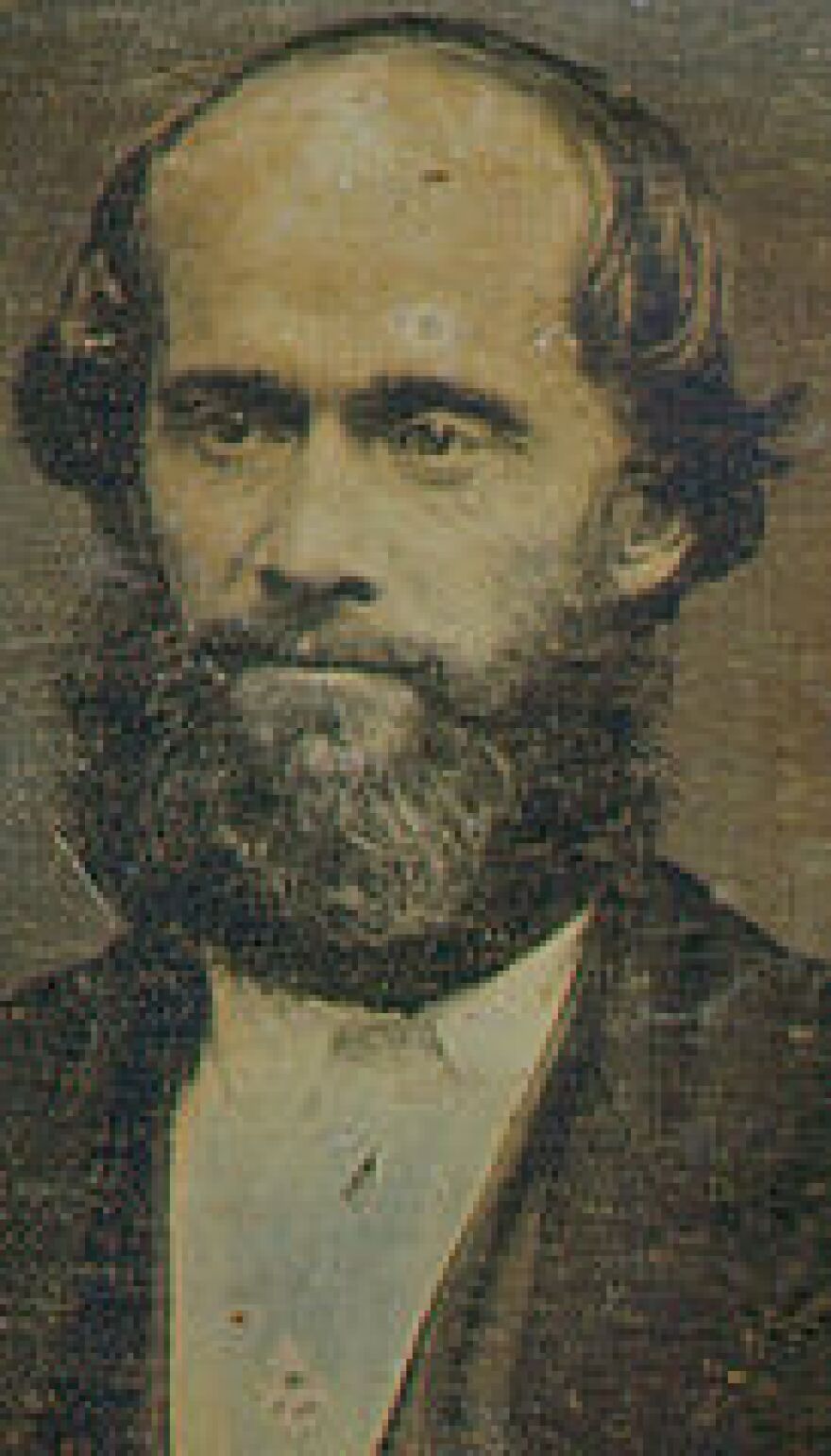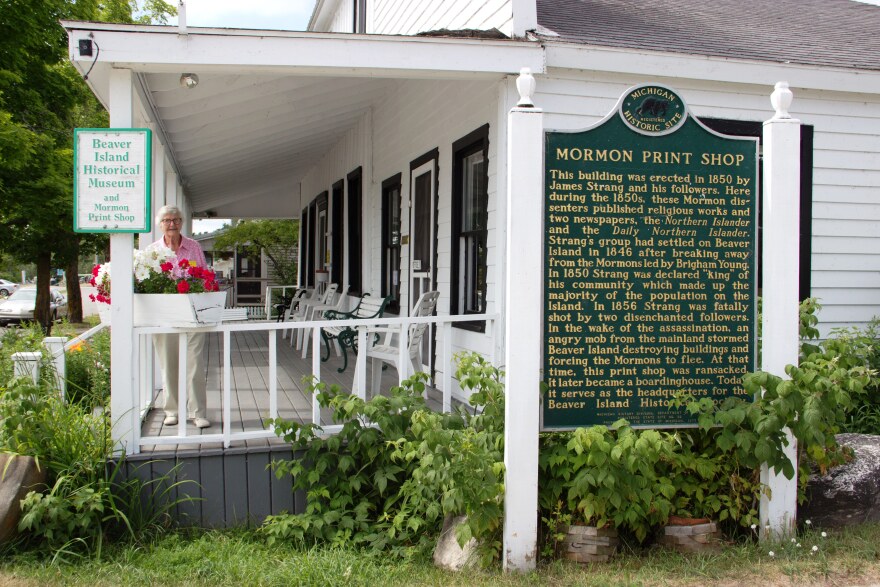As part of our MI Curious project, Philip Zoutendam asked this question:
What's the story of the Mormon kingdom that was on Beaver Island in the 1800s, and how does it affect the island today?
Sarah Hulett boarded a ferry in Charlevoix and headed over to the island to find some answers. What she found was a story of murder, intrigue, and a Mormon population that’s completely vanished.
Who was James Strang?
In the 1840s, James Jesse Strang was a lawyer in the Wisconsin Territory who converted to Mormonism just five months before Joseph Smith, the founder of the Mormon faith, was killed by a mob in Illinois.
Smith’s death created a crisis for the church, with a handful of people competing to succeed him. Brigham Young, of course, is the most well-known. But Strang produced a letter authored by Smith, postmarked days before Smith's assassination in 1844, which named Strang his successor. Strang also claimed an angel came to him “to ordain him as ruler of God’s people,” according to Roger Van Noord’s book Assassination of a Michigan King.Strang said the angel directed him to an oak tree, under which were buried three brass plates covered in symbols that Strang translated with the help of stones the angel presented him.
Brigham Young took his followers to Salt Lake City, where the Church of Jesus Christ of Latter-Day Saints is now headquartered.
James Strang took his disciples first to Voree, Wisconsin. Then, in 1847, Strang reported he’d had a vision, as Van Noord quotes here:
“I beheld a land amidst wide waters, and covered with large timber, with a deep broad bay on one side of it."
That land was Beaver Island.
A mission in the wilderness
According to Van Noord, when Strang and his followers arrived on the island:
The year-round residents included three white families, a handful of white men with Indian wives, and twenty or thirty other men who had families elsewhere. Most of the men were fishermen and the fishing business helped increase the number of men – and boys – on the island to about 100 in the summer. And on the northern side of the island, there were forty to fifty Indian families, predominately Chippewas, who also subsisted mainly through fishing.
Over the next nine years, Strang would transform the island into a bustling outpost. He and his followers built roads and homes, and published a newspaper, The Northern Islander, “which started out as a weekly, and became a daily,” says Joyce Bartels of the Beaver Island Historical Society. “It was the only daily newspaper north of Grand Rapids at that time.”
In the mid-19th century, the lakes were like an economic superhighway, and the Mormons made money selling cordwood to passing steamers.
“The Mormons were very industrious,” says Rob Cole, an amateur historian born and raised on Beaver Island. “They built many of the roads here that still exist today. They built a lot of the modern infrastructure of the island…. They cleared land for farming, they attempted to build water projects like canals and irrigation.”
But there were also growing tensions between of Strang and his followers and the non-Mormons on Beaver Island.
“There was a lot of resentment against Strang, there was a lot of suspicion,” says Cole. “There was a lot of hostility toward the Mormon faith in the United States at that time. It was still a fairly young religion, and it had what some would call somewhat theocratic tendencies.”
Coronation of a king
In 1850, Strang was crowned king in a coronation ceremony choreographed by a man in his inner circle who’d been an actor. Strang “supposedly wore a red robe and he had a cardboard crown,” says Joyce Bartels.

Strang never apparently claimed sovereignty over anything but his church. But it appears his authority over islanders did extend beyond just his disciples.
“Some of the Mormons did actually buy property, but a lot of it was consecrated for the church, and portioned out by Strang to the different [Mormon] families living here,” says Bartels.
Strang also courted controversy among his own followers when he reversed his views about marriage and became – first covertly and later openly – a polygamist, eventually marrying five women.
And it turns out, declaring yourself king can draw unwanted attention from the U.S. government.
The same year as Strang’s coronation, he was arrested and accused of treason and other crimes. A Navy vessel patrolling the Great Lakes, the USS Michigan, ferried Strang and some of his men to Detroit for a trial.
Strang conducted his own defense.
“Strang was a very charismatic speaker, apparently,” says Bartels. “They were acquitted.”
The episode seemed to bolster Strang’s popularity. A few years later, he was elected to his first of two terms in the Michigan Legislature.
Turns out, declaring yourself king can draw unwanted attention from the U.S. government.
Bartels says his victories at the polls also speak to the fact that Strang had built a formidable settlement on Beaver Island.
“There were more people here to vote than in all the rest of the legislative district,” she says. “There was very little settlement in the northern part of Michigan at that time. Charlevoix was just a few huts. It was called Pine River. And the main settlement was at Mackinac Island, St. Ignace, and St. Helena.”
The end of a kingdom
In June of 1856, the USS Michigan – the same naval warship that took Strang to trial in Detroit – was again docked in the harbor at St. James.
The story goes that Strang was invited to join the captain on the ship for dinner. And as he walked down the dock, two men shot him in the back and the head.
Historian Rob Cole says it’s not clear just how involved the U.S. government was in the attack on Strang. But the two assailants and their families were whisked away on the USS Michigan.
They were never charged with a crime. Strang died of his injuries in Wisconsin a few weeks after the attack.
Beaver Island, then and now
So, that answers the first part of Philip Zoutendam’s question. But what about the second part? How does this rather bizarre chapter from the middle of the 19th century affect the island today?

I’ll confess here that reporters often get ideas about the “ideal” story before we actually set out to report and write it. And in this case, I’d imagined finding the descendants of some of those Mormon families still living on Beaver Island.
I was disappointed. They’re gone. All of them.
About 200 Mormons left the island when Strang was brought to Voree, Wisconsin to die. A mob drove the rest of his disciples off the island a couple weeks after that. They burned the Tabernacle and Mormon homes, and forced people onto boats with just the clothes they were wearing.
But descendants of those Mormon families do make pilgrimages to the island.
“It’s common for them to go to the island. Probably quietly,” says John Hajicek, a Mormon historian who’s working on a book about James Strang. “I don’t know that everyone gets off the boat and makes an announcement as to their religious faith. They’re more curious about where the Mormons lived, and how they lived on the island.”
Rewriting history?
Hajicek says part of the reason the history of James Strang isn’t better known is that the Irish families who settled the island after the Mormons were pushed off have, to some degree, rewritten its history.
“They’re big on trying to create a strong Irish heritage,” Hajicek says, and “tried to erase the Mormon heritage” along the way.

It’s hard to see that that’s the case today, what with a museum dedicated to that chapter of the island’s history, and a big historical marker marking the site of Strang’s assassination on the main drag of St. James (not to mention the fact that roads, lakes and St. James itself still bear the names from that era).
But Rob Cole says there was a lot of hostility toward Strang by those who drove him off. And even though the Irish settlers who followed weren’t directly involved in that chapter, “they were aware of what had happened, and they were Irish Catholics, and Strang was the leader of what to them was a new and strange and probably illegitimate religion.…
“I would say there was kind of a lingering resentment toward them and dislike of that chapter of this place’s history,” says Cole.
One example of that lingering resentment that persisted through generations, Cole says, was the renaming of the Beaver Hotel.
The hotel, built in 1901, was purchased by Cole’s uncle, Everett Cole, in the 1930s.
“He renamed it the King Strang Hotel,” says Cole, “and it was not a popular decision on his part. There were still many people living here who were second and third generation Irish who were bitter about that whole era and thought it was crass of my great-uncle to rename the hotel that way.”
But Cole says he thinks most modern-day islanders view the Strang period mostly as a historic artifact, and he says few, if any of them, still hang onto that animosity.
Salt Lake City … East?
Even if outright hostility toward Beaver Island’s Mormons is a thing of the past, Mormon historian John Hajacek says there’s still plenty that’s misunderstood about Strang.
Hajicek says the stories about Strang that hold the widest appeal focus on sex, power and greed. But he says Strang had some very progressive ideas, and they deserve a closer look.
Was Strang a petty tyrant with delusions of grandeur, or a free-thinker ahead of his time on issues like women's rights?
Hajicek says Strang was an abolitionist. He believed women and African-Americans should be allowed to hold the priesthood. He supported the rights of Native Americans. He was an environmentalist, who encouraged forest preservation.
And Hajicek says Strang’s controversial views on polygamy are misunderstood, too. Hajicek says unlike his rival, Brigham Young, Strang’s take on polygamy allowed women to choose a reproductive mate.
I ask Hajicek to imagine what Beaver Island might look like today had Strang lived.
“Oh, I think a better question is what would all of Northern Michigan look like,” he said. “Because James Strang was settling people on the mainland too, not just the island. And there was very rapid growth right then in 1856 for his movement.”
Hajicek says maybe Beaver Island would look like a Manhattan west. Or a Salt Lake City east.







